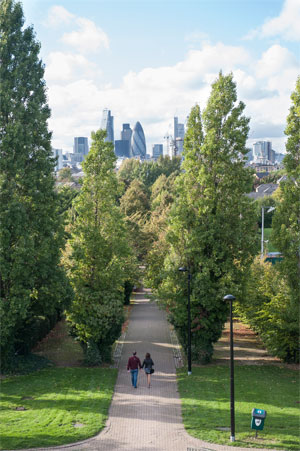UK property: London’s Canada Water set for a reinvention

Simply sign up to the Life & Arts myFT Digest -- delivered directly to your inbox.
Canada Water is undergoing its second regeneration in 30 years in an effort to overcome its reputation as the ugly duckling of London’s Docklands.
This part of the capital’s southeast, near the suburb of Rotherhithe, thrived more than half a century ago as a dock for Canadian freighters. The dock shut in 1969 and lay derelict until it was developed in the 1980s, as part of the commercial and residential transformation of Docklands, a waterside swath stretching east from Tower Hill to Woolwich.
But while the financial services sector funded skyscraper offices and high-value homes at Canary Wharf close by, less glamorous Canada Water had a glut of soulless modern blocks. Now developers have spotted an opportunity and the area is likely to be the location for one of London’s biggest housing developments.
A short walk around the area confirms how much a transformation is needed. The sprawling Surrey Quays shopping centre dominates the horizon. Built on part of the dock in 1989 with large-scale, surface-level car parking, it now looks outdated and attracts chiefly mid- to low-market retail occupiers. A large printworks is a tribute to brutalist architecture. Even the more recent 24-storey residential Ontario Point and low-rise blocks of flats, built by volume developer Barratt Homes, fail to set the pulse racing.
As a result, the area is distinctly underperforming in terms of good quality private housing. One-bedroom apartments start at £145,000 and three-bedroom apartments are between £240,000 and £500,000. Only a few homes have fetched prices commonly associated with “prime” London: a four-bedroom penthouse at the nearby New Caledonian Wharf scheme is on sale with Hunters for £1.5m and a three-bedroom renovated former pump master’s cottage is being marketed by Foxtons and City Docklands at £999,999.
Sales website Zoopla says the average asking price for homes on sale in Canada Water is £368,596, while the average asking rent is £1,731 per calendar month. By contrast, Canary Wharf is £450,348 and £2,092 respectively.

These modest figures are surprising given Canada Water’s transport infrastructure. London Underground’s Jubilee Line extension (opened in 1999) means that Canary Wharf is three minutes away, while Bond Street in the West End is less than 15 minutes away.
The arrival of London Overground in 2010 meant the area became a 10-minute ride from the City of London. And from 2018, Crossrail – the £16bn 70-mile rail service, which includes a stop at Canary Wharf – will place Canada Water within an hour’s travel time of Heathrow.
The existing and forthcoming transport links have done two things to the housing market. First, they have increased demand in the area, especially from those working in the financial services sector. Helen Penfold, of Hamptons International, says this is because Canada Water is less expensive than nearby areas, such as Shad Thames and London Bridge.
Chris Early, of Kinleigh, Folkard & Hayward, says 30 per cent of his Canada Water purchasers are now investors (up to half from China) seeking properties to let. “We’ve had 20 buyers for every property we’ve taken on since the start of the year,” he says.

The second effect of Canada Water’s improving transport infrastructure has been the growing interest from developers. London Residential Research says that 2,228 homes are under construction at Canada Water, with consent secured for a further 2,865.
The largest residential scheme by far, now awaiting planning approval, is by Sellar Property Group for 1,030 homes including some in a 40-storey tower. They would be accompanied by shops, a cinema, open space and children’s play areas, and arranged in what the company describes as a “town square formation”.
“People are worried we’re going to build an identikit of Canary Wharf, but it’s not like that,” says James Sellar, the son of Shard developer, Irvine Sellar. “There will be a public realm including a town centre for Rotherhithe. There are people whose families have lived here for five generations. We respect that.”
He promises to pre-release units to local residents before offering them to the east Asian investors who have become the traditional bulk buyers of many new London schemes.

“Prices are likely to start at £500,000 for a two-bed apartment,” says Sellar. “I’m convinced there’s pent-up demand and the buyers will not all be investors. Some will be local.” He says building is likely to start early next year with the project complete by 2020.
Sellar’s high-rise creation would see the first significant volume of £1m-plus homes in the area, but it is only part of the makeover at Canada Water. An “inverted pyramid” library, funded by the local authority, has just opened, while mixed-use developer British Land wants to attract a Waitrose supermarket and John Lewis department store within four years.
British Land also has a longstanding proposal for 1,000 homes on the printworks site close to the library, while talks are under way to include up to 600 student apartments and campus facilities in a venture by King’s College London.
When this extensive regeneration is finished, Canada Water will become a location with prime-priced properties and an appropriately upscale infrastructure. Whether it ever rivals the status of Canary Wharf, however, remains to be seen.
——————————————-
Buying guide
● Prices in Canada Water have risen 5.58 per cent over the past year and 12.48 per cent in the past five years
● The Surrey Docks area, which includes Canada Water, had 85 reported crimes in August this year
● There are five primary schools and five state secondary schools close to Canada Water
What you can buy for . . .
£500,000: A three-bedroom apartment close to transport links
£1m: A high-spec apartment with views of Canary Wharf
Comments